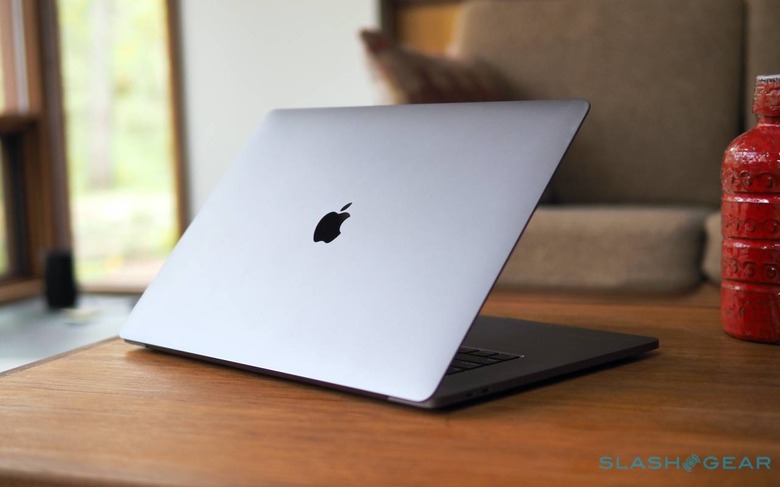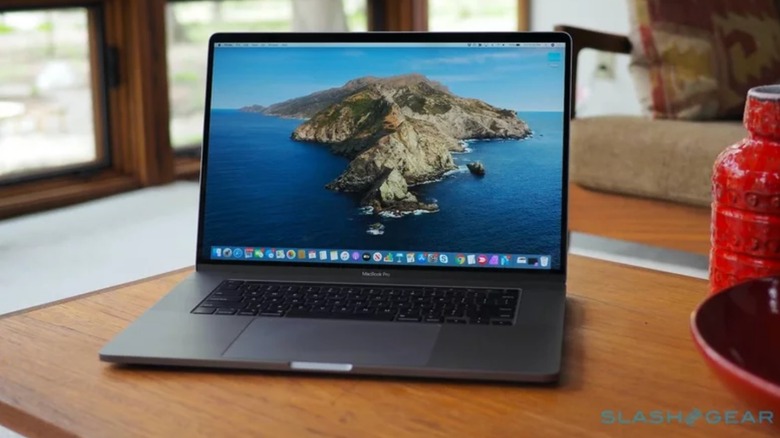Apple MacBook Pro 16-Inch Review: After 5 Months, I'm Convinced
- Magic Keyboard replaces the old Butterfly keys
- Masses of performance from CPU and GPU
- Excellent battery life
- Superlative build quality remains
- 16-inch display is more usable
- Power comes with weight
- No USB-A or SD slot
The 16-inch MacBook Pro has a lot to prove, not least with its Magic Keyboard, but arguably just as much about whether it still fits the definition of what "professionals" are looking for. The new keyboard is about as close to a mea-culpa as Apple gets, but this flagship notebook needed to deliver more than just different keys. It's the sort of improvement that only time can tell whether it's worked or not – so that's just what I gave it.
The last few iterations of the 15-inch MacBook Pro have proved frustrating to some owners, and to some extent so did the early reviews of it. There's an urgency when you're writing about a new product: potential buyers are waiting, wallet or purse in hand, to know whether they're making the Right Decision, and many rely on those first couple of waves of reviews to sway their hand. It's important that they have that guidance, but it doesn't capture everything about the device in question.
Longer-term issues don't have time to surface when you're judging something after a week or two of use. The experiences of a well-traveled reviewer can often make it much easier for them to see potential pluses or minuses much quicker than someone who, say, only encounters a new laptop every 2-3 years. However there are some headaches, hiccups, or general caveats that simply aren't going to arrive until you're months down the line.
A laptop is a big tech purchase, one of the biggest many people will make. The 16-inch MacBook Pro starts at $2,399; that makes it even more important that it's a machine users can rely upon. I wanted to give it as fair a shake as I could; five months later, here's what's working for me – and what isn't.
Ready and willing to travel
There are a lot of people, I know, who consider the 16-inch MacBook Pro – and the 15-inch before it – too big to use as a travel notebook. I'm not one of them. It may be the heaviest single item in my backpack, but it's also the most functional.

I won't lie, my back does occasionally miss the days when I took a 12-inch MacBook on the road with me. The reality is, though, that these days I'd really either need a 13-inch or this 16-inch MacBook Pro, and there the difference in weight (3.1 pounds versus 4.3 pounds) is overshadowed by the difference in performance.
Even the latest, 2020 update to the 13-inch MacBook Pro – which arrived with its Magic Keyboard update just this month – doesn't have a discrete graphics option. The Intel Iris Plus graphics on the higher-end configuration are solid, but they don't hold a candle to the AMD Radeon Pro 5500M in the 16-inch MacBook Pro I've been testing. Portability absolutely comes with a compromise in performance, and when I'm trying to squeeze writing, photo processing, and video editing into every available moment I can, a prolonged wait for 4K footage to render isn't something I'm wiling to accept.
Power in general has left me with no complaints. I've been using a 2.4GHz eight-core Intel Core i9 with 32GB of RAM, and as you'd expect it just flies along. Being able to crunch through large numbers of RAW image files without watching a progress bar is a joy; seeing effects and edits happen instantly in Final Cut Pro X makes any thoughts of downsizing to something more portable fade away.

There are other advantages to the bigger chassis. Apple's speakers sound great, with a surprising amount of bass, and the three-mic array is unexpectedly good. I've even used it to record a quick voiceover when I've not had my regular microphone with me, and though I'm not saying I'll always be leaving the latter at home now, the results were more than usable. The quality has paid dividends in this new age of extended working-from-home for video calls, too, even if that has also highlighted Apple's refusal to upgrade from the 720p webcam. I wouldn't argue with Face ID being added, either, though unlocking either via my Apple Watch or the Touch ID sensor has proved fast and reliable.
Thinner bezels, bigger practicality
What's been interesting is working desk-bound over the past couple of months, as COVID-19 has put a halt on any work travel. Again, one of the reasons I choose to deal with a larger, heavier laptop on the road is because that same machine can handle all the video editing and other tasks I throw at it when I'm back home. There's no need to worry about transferring files or projects not being open where I left them.

With the 16-inch screen I haven't felt the need to plug in an external display. I've been training myself to make better use of macOS' virtual desktops, and as a result I've found I can keep up with several projects on the go simultaneously, without getting confused. There's the option to switch the Retina display from its default – which looks like 1792 x 1120, but much smoother since the native panel is 3072 x 1920 – to the "More Space" option that looks like 2048 x 1280. My aging eyes can only handle that for so long, though, never mind the 3,072 x 1,920 native resolution third-party apps can unlock.
I'm still disappointed that Apple hasn't made more use of the Touch Bar. My hope remains that, just as the iPad Pro has become more laptop-like, so eventually Apple will relent and allow the MacBook Pro to become more tablet-esque. I, like a lot of people, would love to see a full touchscreen.

My day to day experience with the Touch Bar has been more gratifying, though, since I made better use of Automator and Quick Actions. The ability to make macro routines for my most common tasks – things like converting image files to JPEGs and realizing them – and then pin those actions to the Touch Bar has quickly made reaching up there a muscle-memory. Automator is one of those fiendishly-powerful but also fairly complex things that could do with a user-friendliness makeover, much in the way that Shortcuts has made customizable actions easier on iOS devices.
A familiar new keyboard
The saga around the Butterfly keyboard mostly passed me by. I was one of the strange people who liked, not only the regular Butterfly keys, but the version on the original 12-inch MacBook. Perhaps I was just lucky, but I seemed to avoid the sticky-key glitches that soured many on the old 'board.

Switching to this new Magic Keyboard with its scissor mechanism took a little getting used to, and initially I wasn't really a fan. There's definitely a little more keycap wobble than you got on the Butterfly keys, the keys themselves are a little smaller, and the longer travel feels different too. That only lasted a week or so, though, and since then I've been impressed.
My criteria for a great keyboard is one that fades into the background: you just don't notice it any more, and you don't have to change your typing style to accommodate its foibles. I still prefer the key sound preferable from the old Butterfly mechanism, though I suspect most will lean toward the new Magic Keyboard's click, but otherwise I'm a convert. I hadn't realized how much I missed a physical Escape key, too.

With all the strengths come some frustrations
Contributing to my back's discomfort is the 16-inch MacBook Pros' huge 100-watt-hour battery. It's the biggest in an Apple notebook to-date, and in fact the biggest the company could fit before colliding with the FAA's rules about electronics on planes.
The fact that Apple is still promising usage figures in line with the old MacBook Pro – 11 hours of wireless web browsing, or of movie playback – tells you just how power-hungry these new components are. Having lived with the notebook for these months, though, I'm definitely pleased with Apple's decision process there.

Obviously, trying to edit videos and do system-intensive tasks is going to drain your battery more rapidly. When I'm just typing, doing basic photo edits, and dealing with emails and social media, though, the 16-inch MacBook Pro has been lasting far longer than the last-generation 15-inch model could. 7-8 hours is perfectly workable under those conditions, macOS automatically switching to the more frugal Intel graphics when you're not being demanding.
It feels like I've been dragging around the same little bag of dongles for years now, to convert the MacBook Pro's four Thunderbolt 3 ports to either an SD card slot or a USB Type-A. How you apportion the blame for my frustration, whether it's Apple's stubbornness or the tech industry's sluggishness in embracing USB Type-C in general, doesn't really matter to me by this point. I just wish my laptop had an SD card slot.

The wireless age of image transfers simply hasn't panned out like some predicted it would. My camera has WiFi and Bluetooth, but no desktop app. I can AirDrop photos and videos from my iPhone but, like everything else, Airdrop works up until it doesn't. Like the best, most frustrating tools, it's great, up until it isn't. It only takes a couple of times sitting at an event, wondering why my phone can see every other Apple device around bar the laptop right in front of me, to remind me why cables still haven't gone extinct.
16-inch MacBook Pro Verdict
Keyboard headaches may have epitomized the last of the 15-inch MacBook Pro models, but they weren't the only complaint. Heat, battery life, and a sacrifice of performance to maintain a slim profile were also among the issues some pro-users had. Apple has, happily, risen to those challenges.
The 16-inch MacBook Pro hasn't had a problem with heat even while I've been pushing it hard; it hasn't sacrificed everyday battery life; the keyboard is much more reliable. To get all that, you have to accept a thicker, heavier notebook. That's just physics, unfortunately, and if you have an issue with that there are of course alternatives.

You can, for example, do plenty with a potent desktop and a multi-monitor rig, but at some point you have to leave that behind. Even just getting used to not having a single external display when you leave your desk can be frustrating, I've found. I'm much happier having a self-contained system that I use exactly the same way, regardless of where I am.
That's what "Pro" means to me: that ability to get things done with one computer, with a single laptop. You pay for the privilege, and you have to buy into Apple's vision of things like ports and touch, but I suspect many will be willing to do that now the heat, battery life, and keyboard questions have been settled. The 16-inch MacBook Pro looked like a great notebook on day one, and five months later the shine hasn't worn off.
